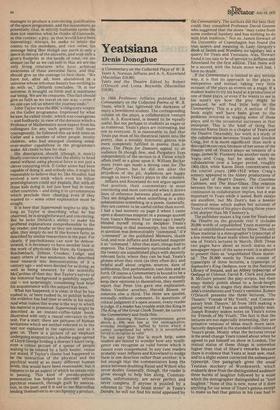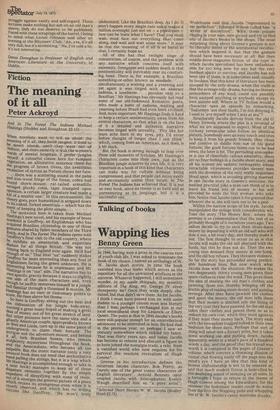Yeatsiana
Denis Donoghue
A Commentary on the Collected Plays of W. B. Yeats A. Norman Jeffares and A. S. Knowland (Macmillan £10.00) Yeats and the Theatre Edited by Robert O'Driscoll and Lorna Reynolds (Macmillan E10.00) In 1968 Professor Jeffares published his Commentary on the Collected Poems of W. B. Yeats, which has lightened the darkness of many a bewildered student. The corresponding volume on the plays, a collaborative venture with A. S. Knowland, is bound to be equally useful. But not perhaps to students as eager or as numerous. Yeats's plays are interesting, but not to everyone. It is reasonable to feel that Yeats put most of his theatrical talent into the poetry, that a notably histrionic genius was more completely fulfilled in poems than in plays. The Plays for Dancers appeal to an audience fit though few, and Purgatory lives independently of the section in A Vision which offers itself as a gloss upon it. William Becker many years ago made a strong case for The Player Queen, but he did not alter the prejudices of the pit. Audiences are happy enough to leave Yeats's plays to the scholars.
Jeffares and Knowland do not argue against that position, their commentary is most convincing and most convinced when it draws lines of reference between plays and poems. They are delighted when something in a play substantiates something in a poem. Generally, they are content to be useful rather than novel. I had a bad moment on page 2 when I came upon a disastrous misprint in a passage quoted from Yeats's Memoirs. Four years ago I nearly blinded myself trying to decipher Yeats's handwriting in that manuscript, but the word. in question was demonstrably "commend," it's -commend" in the published Memoirs, thank God, and now Jeffares and Knowland misprint it as "command." After that start, things had to improve. The Commentary surrounds each of the twenty-six unpublished plays with decently relevant facts, where they can be had, Yeats's glosses when they exist (as they often do), and helpful stuff about origins, sources, date of publication, first performance, cast-lists and so forth. Of course a Commentary is bound to be a pretty straitlaced book, the authors normally keep their opinions to themselves, they merely report that Peter Ure gave one explication, Helen Vendler another, Harold Bloom or someone else a third. The three are quoted, normally without comment. In questions of critical judgment it's open season, every reader is judge. If a reader has trouble with the King in The King of the Great Clock Tower, he turns to the Commentary and finds this:
Rajan, doubting Wilson's interpretation given above, p. 256, sees him as 'the unimaginative, everyday intelligence, baffled by forces which it cannot comprehend but which it is nevertheless forced to recognise as valid.'
not sure that this is much help, some readers are bound to wonder how any intelligence can recognise as valid forces which it cannot even comprehend. In any case readers probably want Jeffares and Knowland to nudge them in one direction rather than another; it is not enough that the commentators keep the peace between doubting Rajan and Wilson who never doubts. Generally, though, the reader is given enough to help him along. Commentaries, unfortunately, are never perfect and never complete. If anyone is puzzled by a reference to the hot Istain stone" in Yeats's Deirdre, he will not find his mind appeased by
the Commentary. The authors did the best they could, they consulted Professor David Greene who suggested that the stone "may come from some medieval lapidary and has nothing to do with Irish tradition." Not so. James Stewart of the University of Copenhagen has found the true source and meaning in Lady Gregory's Book of Saints and Wonders, no lapidary but a quarry for Yeats and Yeatsians. Alas, Stewart found it too late to be of service to Jeffares and Knowland for the first edition. That there will be a second, with the Istain stone well laid, I have no doubt.
,If the Commentary is limited in any serious way, it is that its approach to the plays is interpretive and textual, taking very little account of the plays as events on a stage. If a student wants to try his hand at a production of one of these plays, or even if he wants to see in his mind's eye how the play might be produced, he will find little help in the Commentary. This is a pity. A section of the book might well have been given to the problems involved in staging some of these plays, and to the occasional successes in that enterprise. This is the kind of thing that interests Karen Dorn in a chapter of Yeats and the Theatre. Ostensibly, her work is a study of thecollaboration between Yeats and Gordon Craig, but it is more significant than such a description conveys,: because of her sense of the theatre and of Yeats's plays as tenants of a stage. James W. Flannery has another essay on Yeats and Craig, but he deals with the collaboration over a longer period, roughly 1903-1914, while Karen Dorn concentrates on the crucial years 1909-1912 when Craig's scenery appeared in the Abbey productions of The Land of Heart's Desire, The Countess Cathleen, and The Hour-Glass. The relation between the two men was not as close or as continuous as collaboration implies, but it was important to Yeats while it lasted. Both essays are excellent, but Ms Dorn's has a keener theatrical sense which makes her account of Yeats's revisions of his plays during those years a bit sharper than Mr Flannery's.
The publisher makes a big case for Yeats and the Theatre on the grounds that it includes 20,000 words of unpublished Yeats material as well as unpublished material by Shaw. The only Shaw material is a stenographer's typescript of a few remarks Shaw made when he presided at one of Yeats's lectures in March, 1910. These two pages have about as much status as a newspaper report of the same event: it is absurd to present them as "unpublished Shaw material." The 20,000 words by Yeats consist of typescripts of three lectures, a typescript of Sophocles's King Oedipus, now in the National Library of Ireland, and an Abbey typescript: of Oedipus at ColonuS. David R. Clark and James B. McGuire present the play-scripts, but their essay mainly points ahead to a book-length study of the six stages they describe between Jebb's translations and Yeats's versions. Robert O'Driscoll presents the three lectures, 'The Theatre,' Friends of My Youth,' and 'Contemporary Irish Theatre,' all from 1910 making a partial record of Yeats as smiling public man. Joseph Ronsley makes notes on Yeats's notes for 'Friends of My Youth.' The fact is that the lectures are not especially interesting, they are primitive versions of ideas much more satisfactorily deployed in the standard collections of Yeats's prose. Mostly what the lectures reveal is the small change Yeats tossed about when he agreed to put himself on show in London. The textual status of these things is somewhat higher than that of Shaw's remarks because there is evidence that Yeats at least saw, read, and to a slight extent corrected the subsequent typescript. One paragraph gives the usual Yeatsian mockery of Wordsworth, which evidently drew from the distinguished audience three bursts of laughter followed by a noise which the stenographer distinguished as "loud laughter." None of this is new, none of it does anything for our sense of Yeats's genius except to make us feel that genius in his case had to
struggle against vanity and self-regard. These lectures make nothing but ash on an old man's sleeve, they do not deserve to be published.' Faced with these scrapings of the barrel, I bring to mind what Lionel Johnson said after an evening at the Rhymers' Club, -Ah, yes, it's all very dull, but it's interesting." No, I've told a lie, it's not interesting.
Denis Donoghue is Professor of English and American Literature at the University 'of Dublin.



































 Previous page
Previous page